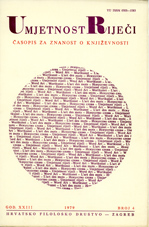Pojam konteksta u znanosti o književnosti
The Consideration of Context in Literary Theory
Author(s): Sonia BićanićSubject(s): Language and Literature Studies
Published by: Hrvatsko filološko društvo
Summary/Abstract: Linguists, especially during the last fifteen years, have become increasingly interested in situated language and communicative competence. The basic communication model (fig l) was first made relevent for literature by Jakobson building on Biihler (fig 2). In later linguistic communication models it was soon remarked that sender and source need not be one, nor need receiver and addressee. This is an important notion for critics and teachers of literature, since students frequently receive texts not direct but through the medium of another mind. More important the notion of noise came to be extended from physical to psychological noise, this refers to something in speaker or hearer preventing the message from being received as intended. Individuals have a repertoire of communication abilities which come into play both in sending and receiving messages. This repertoire is built up over time and composed of the whole amalgam of what makes us individuals. Layer on layer it is created from our linguistic skills, national, family, moral and social background, the jobs we do, the generation to which we belong. Linguistic competence and social competence together form our communicative competence. The more situations an individual can function in, in our sense the more writing he is capable of appreciating, the greater the breadth and sensitivity of his coifununication abilities. Fig 3 shows this extended model of communication. The vital area here is the shaded section. The more nearly sender's and receiver's repertoires coincide the more extensive will be the shaded section, and the more nearly will the message get through as intended. The relevance of this model for literature is clear. It would seem that an important part of our work as teachers and critics would be a reduction of psychological noise. But we must never forget that we too are part of the context of situation. We too are subject to psychological noise. Thus we have communication model 4. This is a double communication situation and a double possibility of noise, one between source repertoire and sender's (critic's or teacher's) repertoire and the second between critic's or teacher's repertoire and the repertoire of the ultimate addressee. In so far as there are a number of ultimate addressees then the noise will be different in each case. Multiple receivers means multiple kinds of noise. Another dimension of literary criticism and teaching made apparent by this model is the possibility for critics of succeeding generations, and for individuals within the course of their lifetime, to make continual reinterpretations and reassessments of literary works. This is possible because psychological mise becomes less or different and in the case of the students the final message received may be the culmination of the insights of many previous scholars and periods. A final model (no. 5) is a dynamic model as given by Argyle in the Psychology of Interpersonal Communication.
Journal: Umjetnost riječi
- Issue Year: 1979
- Issue No: 4
- Page Range: 231-238
- Page Count: 8
- Language: Croatian
- Content File-PDF

